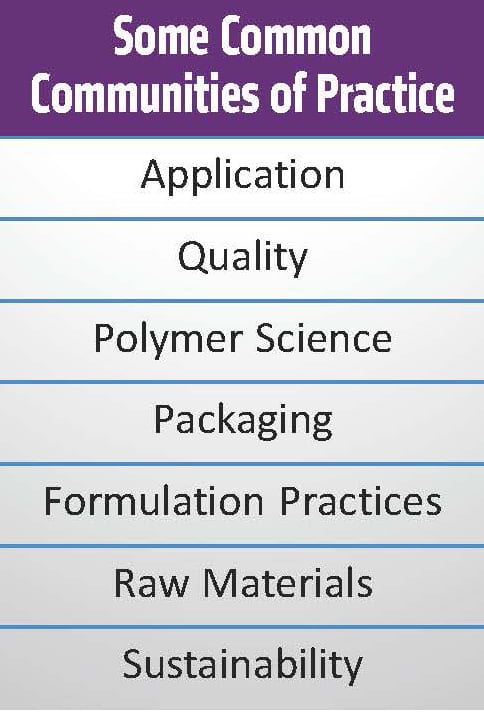By Victoria Scarborough, Ph.D., Materia Prima Ventures
Coatings companies just keep getting bigger and bigger. The hierarchal nature of companies and the size of mergers creates organizational structures that effectively separate employees into silos that result in hampered communication and collaboration. Since both are the backbone of innovation, poor interdepartmental coordination can create a tortuous path to the successful creation of innovative new products. It makes work more difficult and ultimately less productive. Frustration sets in, and employees become disenchanted because getting things done is so hard.
While not a panacea for all the issues of siloed organizations, there is an innovation tool that is designed to bring people together based on a common interest, goal, or concern regardless of where they reside in the organization. These are called Communities of Practice (CoP). Sometimes they are formed organically when employees share a common problem and informally gather to discuss solutions. But many successful companies have purposely formed CoPs to help foster more group discussion around natural domains where expertise can be better leveraged across the company. For the coatings industry, there are some common domains that cross departmental lines that could be considered as relevant CoPs. A few examples are shown in the table below.

Company support is key to facilitating a CoP program. It gives employees permission to work across department lines and form their particular community. CoPs are at their best when they are composed of passionate members who have a keen interest in the subject of the community and are subject matter experts. Often, natural leaders emerge who help organize and recruit others that have similar interests. A few ground rules help give structure to the CoP, like establishing a facilitator and someone to maintain and share discussion notes. In many large companies, there are more formal CoPs with mission statements, goals, and internal web pages. In any case, it helps to have a common vision for what the group would like to accomplish.
There are benefits to establishing a CoP program beyond bridging organizational barriers. Members have the opportunity to interact with each other, even though they do not work together on a daily basis. Exposure to company subject matter experts gives employees with less experience the opportunity to learn and share knowledge. Newer employees can bring fresh perspectives to long-time employees. Members expand their networking opportunities and begin to use new contacts in their daily jobs. In large companies that make acquisitions, CoPs can be a natural place where the acquired employees can meet their counterparts and share their knowledge and expertise. In particular, innovation programs can benefit from CoPs as common research problems are discussed by a more focused, cross-departmental group with specific subject knowledge. Overall, establishing a CoP program can be a useful approach to bridging internal silos, increasing collaboration, and growing company performance. But the biggest benefit is in connecting employees who share a common passion.
CoatingsTech | Vol. 16, No. 1 | January 2019
